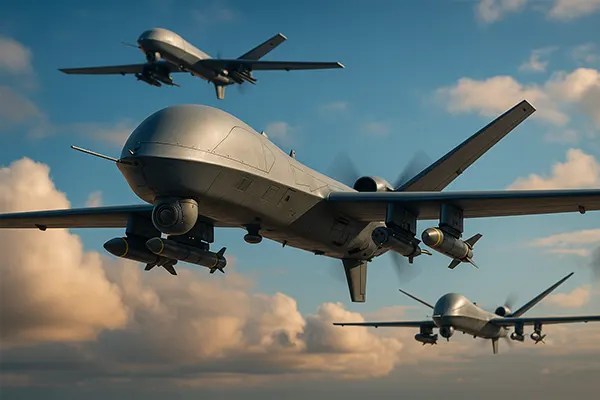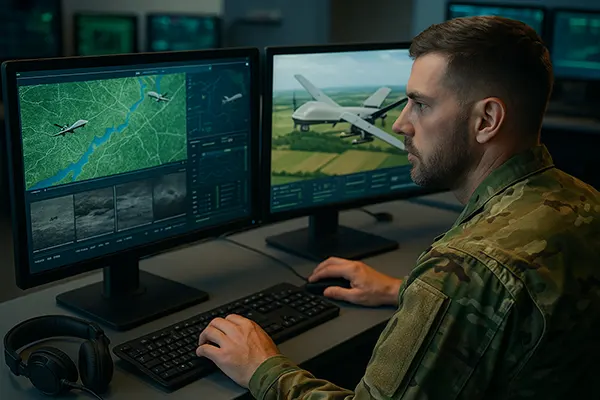Next-Generation Military Drones: How AI Is Transforming Real-Time Combat Tactics

The global defence industry is undergoing a profound transformation, with AI-powered drones at the core of modern warfare strategies. As of mid-2025, numerous countries have actively integrated autonomous aerial systems into their combat infrastructure, leveraging advanced algorithms, real-time decision-making capabilities and collaborative swarm intelligence to outpace conventional tactics. This evolution reshapes both tactical doctrines and operational readiness in response to rapid changes on the battlefield.
AI-Driven Autonomy and Tactical Flexibility in Drone Warfare
One of the most significant advancements in 2025 is the full deployment of AI-based autonomy within military UAVs (unmanned aerial vehicles). Unlike earlier generations that relied on remote piloting, today’s combat drones, such as the U.S. Air Force’s XQ-58A Valkyrie and Russia’s S-70 Okhotnik, are equipped with neural networks trained to make independent decisions under complex combat conditions. These systems process sensor data in real time and select optimal flight paths and target engagement strategies without human intervention.
Real-time adaptability is another defining trait of modern AI-enabled drones. Tactical software, often built on reinforcement learning, enables drones to react instantly to threats, terrain changes or hostile jamming. For example, Israeli Harpy NG drones now use computer vision to navigate dense electromagnetic interference zones and dynamically prioritise targets based on battlefield relevance and threat potential.
AI systems also allow for seamless transition between surveillance, strike and electronic warfare roles. Platforms are no longer confined to a single mission profile. Instead, they autonomously switch functions based on live data inputs and battlefield demands, offering commanders new levels of strategic flexibility and situational awareness.
Swarm Technology and Cooperative Engagement Protocols
Swarming, a concept in which multiple drones operate as a unified network, has moved from theory to operational reality. In June 2025, China’s Ziyan Blowfish A3 and Turkish KARGU-3 successfully demonstrated coordinated attacks during military exercises, utilising decentralised AI to assign roles and prioritise targets collaboratively in real time. This marks a decisive leap toward autonomous joint operations.
These cooperative engagement systems distribute data processing across the swarm, meaning that even if one drone is destroyed, the mission can continue uninterrupted. AI allows each drone to adjust tactics based on the status of others, creating a resilient, decentralised network resistant to conventional countermeasures.
Swarm algorithms also open new possibilities in urban combat. By mapping 3D environments and using predictive modelling, drone groups can conduct precise search-and-destroy operations in densely populated or concealed terrain, significantly reducing risk to ground forces.
AI-Powered Target Identification and Ethical Safeguards
Target recognition, long a weak link in autonomous warfare, has been revolutionised by machine learning. Modern drones are now integrated with high-definition imaging systems and AI-trained classifiers capable of distinguishing between military assets, civilian infrastructure and decoys. This precision is crucial for compliance with international humanitarian law (IHL).
In June 2025, NATO introduced mandatory AI training protocols that require systems to cross-verify targeting decisions through independent algorithmic modules. These dual-check mechanisms are built into the software architecture of combat UAVs, minimising misidentification risks and embedding a legal-ethical framework into real-time operations.
There’s also growing emphasis on human-in-the-loop oversight. While AI may identify and track targets, final engagement often requires operator confirmation, especially in high-collateral-risk zones. This hybrid model aims to balance tactical speed with moral responsibility.
Challenges of Bias, Misidentification and Legal Accountability
Despite advancements, AI models remain vulnerable to bias in data training sets, which can skew target identification. Aerial datasets gathered in one region may not reflect adversary behaviours elsewhere, leading to false positives or overlooked threats. Ongoing testing and regional model adaptation are now standard practice in NATO and allied drone programmes.
Accountability frameworks are also being re-evaluated. Who bears responsibility when a drone makes an incorrect decision: the software developers, commanders, or the state? These questions are actively debated within the Geneva Convention’s tech subcommittee, with several proposed amendments to codify responsibility in algorithmic warfare.
Another unresolved issue involves AI manipulation. In April 2025, a major red-team simulation revealed that spoofed visual markers could mislead drone vision systems, making it imperative to incorporate adversarial defence layers and real-time authentication into drone software.

Logistical Advancements and Tactical Integration of Combat UAVs
Next-generation military drones are increasingly integrated into broader C4ISR (Command, Control, Communications, Computers, Intelligence, Surveillance and Reconnaissance) networks. AI facilitates seamless data exchange between UAVs, satellites and ground units, enabling commanders to make informed decisions based on live, synchronised inputs from multiple sources.
In terms of deployment logistics, the latest UAVs feature modular designs allowing rapid field assembly and repair. Nations like France and India have adopted container-based drone hubs that enable quick launch operations in remote regions. AI-enhanced diagnostics further reduce downtime by predicting failures and triggering pre-emptive maintenance cycles.
Battery efficiency has also improved due to AI-optimised flight paths and smart energy management systems. As a result, long-endurance drones such as the U.K.’s “Proteus-M” can now stay airborne for over 36 hours while maintaining encrypted communication and threat analysis in contested airspace.
Global Strategic Implications and Future Outlook
The proliferation of AI-powered drones is reshaping global security doctrines. Countries that rapidly deploy autonomous aerial systems gain not only tactical superiority but also geopolitical leverage. This is evident in how drone diplomacy is now used in military aid agreements and arms sales, particularly in Southeast Asia and the Middle East.
Regulation and arms control lag behind technological progress. While several treaties address autonomous weapons, enforcement mechanisms are weak. The UN has called for updated frameworks in its June 2025 Geneva briefing, urging consensus on AI-driven weapon usage and oversight mechanisms.
Looking forward, integration with quantum computing and brain-inspired neuromorphic chips may unlock new forms of autonomous decision-making. The challenge will be to balance these innovations with robust ethical governance and clear chains of responsibility to prevent escalation or misuse.




